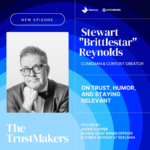By Adam Stanley, Managing Director at Event Concept
In an era dominated by endless short-form content streams, algorithm-driven feeds and AI-generated matter, people aren’t just tired – they’re tuning out. This has sparked a growing desire for something more tangible: presence, connection and real-world value.
In response, brands and media companies are embracing in-person events to build trust, drive growth and foster authentic connections. Events have also become strategic assets, helping companies generate valuable first-party data and fuel content creation across platforms.
Let me explain how in our current, attention-fractured era, live events are no longer just marketing tactics – they’ve become a strategic way for both brands and publishers to blend content, community and commercial value in a way that few other channels can replicate.
The experience economy: why events are booming
Today’s digital landscape, filled with content saturation, algorithm fatigue and AI overload, is leaving audiences feeling overwhelmed and disconnected – and amid the digital noise, people are craving experiences that feel more real, trustworthy and human. This yearning towards more authentic, real-world interactions has sparked a shift towards in-person events and experiential marketing – and more brands and media companies are taking notice.
According to the latest IPA Bellwether Report, brands are allocating a larger portion of their budget to events. While UK marketing budgets have declined for the first time in four years, the highest level of optimism was recorded for events marketing in the first quarter of 2025, with an increased net balance of 12.9%.
Whether in-person or hybrid, events offer a platform for brands and individuals to engage in meaningful ways that can’t be achieved online. As a result, today’s brands are investing in events not just as promotional tools, but as strategic platforms for storytelling, data collection and measurable conversion.
Events as a strategic marketing channel for all brands
Events are no longer exclusive to major media houses or cultural festivals – they’ve become essential tools for brands of all kinds, helping them build trust, drive conversion and generate actionable first-party data in an increasingly privacy-conscious world.
According to Event Marketer, 76% of marketers say experiential marketing is key to brand success. And the results speak for themselves: Time Out, who once found itself struggling with legacy publishing models, credited its £12.4m profit turnaround to its live events division – while the likes of Axios and Semafor (among others) also reported a 48-60% year-over-year events revenue growth in 2024.
One of the most forward-facing opportunities for brands lies in treating events as scalable IP. This model can help shape events into multi-format content strategies that can scale across every media channel:
First-party data from registrations and attendee interactions allows publishers to segment audiences and personalise communications
Content automation turns panels, interviews or behind-the-scenes footage into a pipeline of video, social and editorial content
Hybrid experiences combine physical experience with digital layers, extending reach and monetisation opportunities
New monetisation layers are created, including ticketing, virtual sponsorships and branded extensions
Events as editorial powerhouses for media companies
Publishers aren’t just reporting on the conversation anymore – they’re creating it. Top-tier media companies are also transforming events into extensions of editorial voice, brand identity and business strategy.
Take GQ’s Man of the Year, Vogue World, Wallpaper’s Design Awards, Esquire’s Townhouse and National Geographic’s Explorers Festival. These events aren’t just brand activations – they’re fully-integrated editorial formats, supported by entire content lifespans. From launch moments to B2B summits to thought leadership roundtables, these events generate content fueling weeks (sometimes months) of monetisable storytelling across platforms – including videos, social strategies, photo galleries and behind-the-scenes interviews.
One company that also embodies this pivot is Ascential. The UK-based events marketing company behind iconic franchises like Cannes Lions, Money20/20 and WARC has redefined events not just as convening spaces, but as high-impact media ecosystems. This shift was validated in 2024 when Informa, the UK-based events and business intelligence giant, acquired Ascential’s events division for over £800m. Focused on scaling B2B events, this deal highlighted that events are evolving into scalable, long-term IP assets that transcend beyond editorial and into enterprise value.
What’s next: the 2025 events playbook
Forward-thinking brands are already building what’s next for the events-first model. In 2025, you can expect to see more:
AI-personalised content recaps, with real-time summaries and highlight reels tailored to each attendee
Real-time publishing, which will see more live coverage across platforms to drive relevance
Interactive digital layers at events, such as AR filters, QR codes, gamified experiences and real-time polls to deepen audience participation
Recurring IP with licencing potential, which will help transform events into franchises that can scale globally or support multi-format content engines
Why the shift matters
Events are no longer just celebrations of the content – they are the content. They’ve become high-impact, data-rich channels for brands across industries, offering unique opportunities to engage audiences, gather insights and build meaningful connections. For media companies, events are also now more than just gatherings – they’ve become essential editorial formats and revenue engines.
For everyone, events are no longer the sideshow – they’re now the main stage, where brands and media companies can engage with audiences, create lasting impressions and drive both revenue and meaningful connection.











